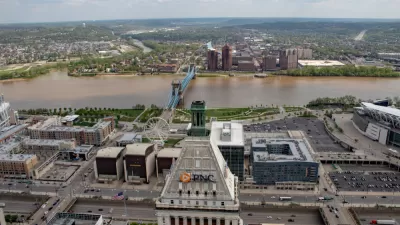General Electric has a strong regional presence in the Cincinnati area, but none of its 10 facilities are located downtown. That is about to change thanks to Cincinnati's urban revival making it an attractive place for the company's younger workers.
There is no lack of articles in Planetizen on Cincinnati's downtown revival, including form based codes, a streetcar proposal saved, a mixed-use tower replacing a parking garage, and reforming an outdated parking code. But there's no greater illustration of its revival than seeing a major company move into a new $90 million downtown facility, bringing at least 1,500 new jobs.
"To take a firm as old as GE, to see these firms start to say that the centers of cities are the preferred location is big news," said Robert Lang, an urban-planning expert and director of Brookings Mountain West.
It's "the latest sign that urban centers in the Rust Belt are becoming more attractive to U.S. corporations," writes Chelsey Dulaney for The Wall Street Journal.
GE executives say they opted for Cincinnati as opposed to more-suburban locations partly because young talent increasingly prefers urban living. The Banks project "has been designed to provide all of the amenities necessary to attract and retain top talent," said Joe Allen, who will manage the new GE center.
The project's name comes from it location along the banks of the Ohio River between the city's two professional athletic stadiums. Planning "began about 15 years ago. Developers and city planners envisioned a mixed-use development on the 18-acre site with apartments, hotels, retail and office space. The total price tag is about $800 million," writes Dulaney.
Of course, financial incentives helped, though they applied to the region as well. "Part of Cincinnati's appeal was the large package of city, county and state tax breaks and other incentives, estimated at more than $100 million over the next 15 years," adds Dulaney.
On a related "cities and suburbs" topic, Alan Ehrenhalt, senior editor at Governing, writes about an Urbanophile Interview of Cincinnati Mayor John Cranley.
The mayor essentially proclaimed that the time has come for cities to stop dreaming of regional solutions to urban problems, to stop thinking that they would be better off if they could annex the suburban territory that lies just outside their borders. Cincinnati, he said, can get along just fine without any more than the roughly 80 square miles and 300,000 people that it currently comprises.
Ehrenhalt continues the discussion with Mayor Cranley in his piece, "Are Suburbs All They’re Cracked Up to Be?"
Correspondent's note: subscriber-only content to Wall Street Journal article will be available to non-subscribers for up to seven days after July 27.
FULL STORY: A Power Surge in the Rust Belt GE to Move Jobs to Downtown Cincinnati

Maui's Vacation Rental Debate Turns Ugly
Verbal attacks, misinformation campaigns and fistfights plague a high-stakes debate to convert thousands of vacation rentals into long-term housing.

Planetizen Federal Action Tracker
A weekly monitor of how Trump’s orders and actions are impacting planners and planning in America.

San Francisco Suspends Traffic Calming Amidst Record Deaths
Citing “a challenging fiscal landscape,” the city will cease the program on the heels of 42 traffic deaths, including 24 pedestrians.

Defunct Pittsburgh Power Plant to Become Residential Tower
A decommissioned steam heat plant will be redeveloped into almost 100 affordable housing units.

Trump Prompts Restructuring of Transportation Research Board in “Unprecedented Overreach”
The TRB has eliminated more than half of its committees including those focused on climate, equity, and cities.

Amtrak Rolls Out New Orleans to Alabama “Mardi Gras” Train
The new service will operate morning and evening departures between Mobile and New Orleans.
Urban Design for Planners 1: Software Tools
This six-course series explores essential urban design concepts using open source software and equips planners with the tools they need to participate fully in the urban design process.
Planning for Universal Design
Learn the tools for implementing Universal Design in planning regulations.
Heyer Gruel & Associates PA
JM Goldson LLC
Custer County Colorado
City of Camden Redevelopment Agency
City of Astoria
Transportation Research & Education Center (TREC) at Portland State University
Jefferson Parish Government
Camden Redevelopment Agency
City of Claremont





























